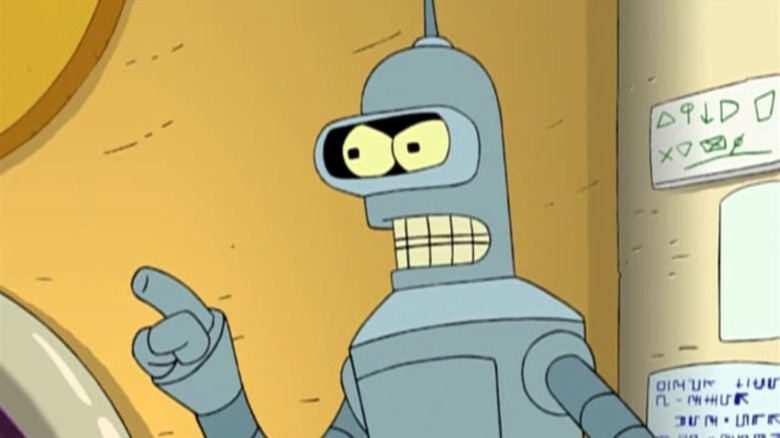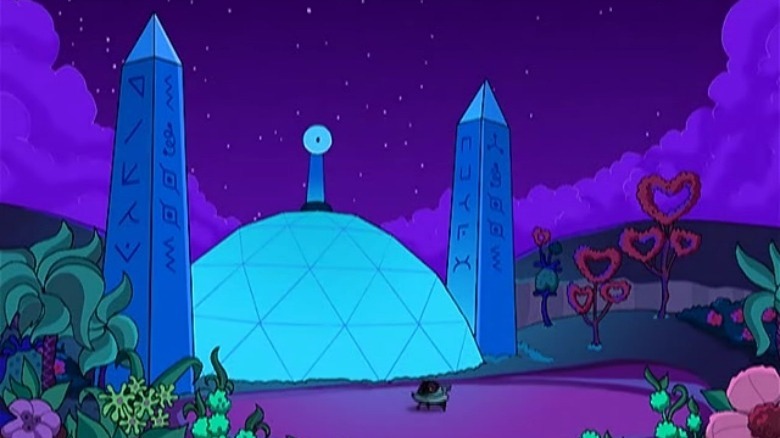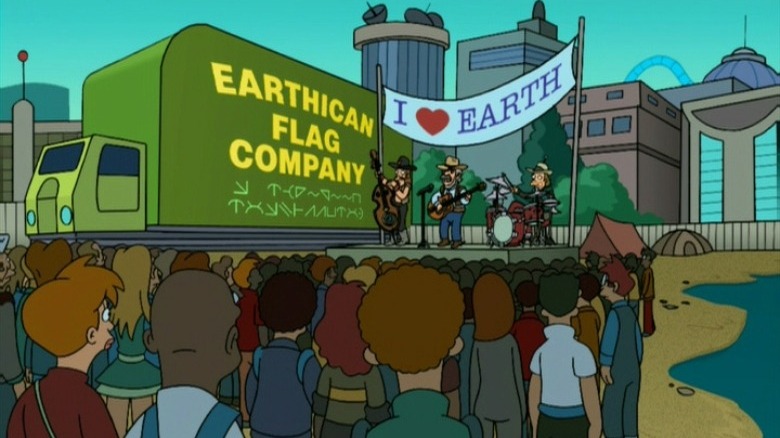Futurama's Second Alien Language Was Actually A Complex Mathematical Code
When the makers of "Futurama" were first constructing the series, they dropped in a prominent background detail that they knew nitpickers and lay-linguists would adore. One can see on billboards, in store windows, and even painted on the sides of buildings, an oblique alien language constructed of curved symbols and dots. The "Alienese" might have been dismissed as a mere design flourish, but the letters were too neatly written and too consistent across the series to be dismissed. It took very little time for "Futurama" fans to crack the code and find that all those alien signs could be translated. It seems that the Alien Language, nicknamed AL1 by fans, was a simple letter-replacement cipher. The cipher became so well known that handy translators can now be found online.
"Futurama" co-creator David X. Cohen was a little disappointed that AL1 was unlocked so quickly. He was, of course, careful to give clues: there is a handy sign in the episode "My Three Suns" (May 4, 1999) that spells out the English word "OPEN" on a storefront, with four corresponding alien letters under it. This, however, might have been too obvious, and Cohen assumed fans wouldn't be so quick on the draw. He might have underestimated how much "Futurama" appeals to math nerds and language nuts.
In the episode "The Day the Earth Stood Stupid" (February 18, 2001), however, the alien language became far more complicated. "Stupid" is the first appearance of AL2, and it was far more than a simple letter-replacement code. This time, the alien language would involve a mathematical code that would take a genius to solve. Cohen and the language's inventor, Jeff Westbrook, would explain their methods on the episode's DVD commentary.
Alien Language 2
Of course, "Futurama" fans solved AL2 as well, but the whole cipher wouldn't be provided until "Bender's Big Score," released in 2007. It wasn't even included on screen. It was one of the many Easter eggs hidden on the disc. Prior to that, "Futurama" fans knew that AL2 was a mathematical code, but it required more information to translate entirely. Once all the information was out there, everyone was able to solve it.
On the DVD commentary track, Westbrook, both the episode's writer and inventor of AL2, pointed to the building pictured above, and the eerie writing seen emblazoned on it. He said:
"Those two obelisks you see briefly at the start of the shot are actually Rosetta Stones for the two alien languages that we have in the show that encode real English sentences. And some of the guys on the internet used those to decode the second alien language, which was quite a feat. Kudos to those guys."
It was Cohen who pointed out that AL2 was not constructed using a trick of linguistics, but of very simple mathematical coding, the type that would be easily decoded by any holder of a major degree in computer science ... which Westbrook holds. Cohen added:
"I want to point out that Jeff Westbrook, who wrote this, has a PhD in computer science. He's sitting here before us. And so using not very many of those skills from graduate school, but just the simplest things you would use as a computer scientist, he designed the second alien language. The first one is a simple replacement as you all know: 'A' is a symbol, 'B' is a symbol. The second one, what type of code is that?"
It is, of course, a modular addition code.
A modular addition code
As Westbrook explains a modular addition code is a code "where the next letter is given by the summation of all of the previous letters plus the current letter. [...] Mod 26, of course." Mod is, as all good nerds know, an abbreviation of Modulo, and is a mathematical operation or function that returns only the remainder of a division problem. As a handy online Modulo Calculator points out: 27 mod 6, is the same as saying 27 ÷ 6 = 4 with a remainder of 3. Hence, 27 mod 6 = 3.
That's just the basic arithmetic, though, for laypeople like me. Those with advanced math degrees know the above information is preschool level. I would need a lot more study to get into Modulo computing operations, and how they can be translated into codes. Thank goodness other "Futurama" fans were smart enough to see and unlock the patterns.
The AL2 code, Cohen explained, was dependent on the letters on either side of it, so each alien glyph would be translated differently depending on its use. That made the code way more complicated than a mere find-and-replace system. As Cohen continued:
"The cool thing about that code is the same symbol could mean two different letters depending on where it appears in the word, in other words. So much harder to decode. And we made it more challenging by only putting it up there against the other alien language, so you didn't even get any English to compare it to. You only got to see the new language versus the old alien language."
Westbrook pointed out that the glyphs on the obelisks next to the geodesic dome could be translated into the phrase "yummy tummy." Using advanced math to tell dumb jokes? There's nothing better.


